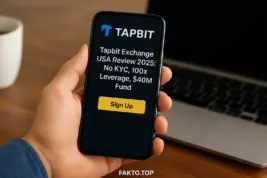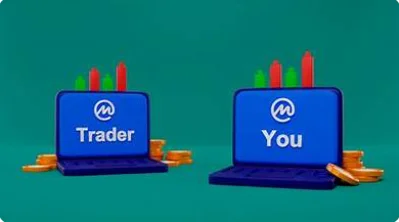Tapbit Exchange USA Review 2025: No KYC, 100x Leverage, $40M Fund
If you’re in the U.S. and tired of getting grilled for your grandma’s maiden name just to trade $50 worth of crypto, Tapbit might be your new favorite playground.
This exchange is registered in the States, holds an MSB license, skips the KYC nonsense (until you really need it), and lets you trade with up to 100x leverage. Oh, and they’ve got a $40 million insurance fund in case things go sideways. Sign up here and see for yourself — but before you ape in, let’s break down what Tapbit actually offers, what it doesn’t, and whether it’s worth your time in 2025.

Regulation, Onboarding, and the “No KYC” Sweet Spot
Tapbit isn’t some sketchy offshore operation. It’s got a legit MSB license from FinCEN, which means it’s allowed to operate in the U.S. legally. That’s already a win compared to half the CEXs out there. But here’s the kicker: you can trade without submitting your ID, as long as you’re not trying to withdraw massive amounts. For most retail traders, that’s a dream. No selfies with your passport, no waiting three days for “manual review.” Just deposit USDT and go. But don’t get cocky — if you’re pulling serious volume, they’ll eventually ask for docs. IRS doesn’t play, and Tapbit’s not gonna take that heat for you. So yeah, it’s “no KYC”… until it’s not. Still, for casual traders and degen scalpers, it’s a breath of fresh air.
Trading Features: Leverage, Copy Trading, and a UI That Doesn’t Suck
Let’s talk tools. Tapbit offers spot trading, perpetuals, copy trading, and even some staking options. The leverage goes up to 100x, which is insane — and probably not for the faint of heart. If you’re new, start small or you’ll get liquidated faster than you can say “rekt.” The UI is clean, fast, and doesn’t feel like it was built in 2017. Mobile app? Solid. Web interface? Snappy. Copy trading is where things get spicy — you can follow top traders and mirror their moves. But don’t expect miracles. Most of these “pros” are just dudes with a few lucky trades and a Twitter account. Wanna test it out? Tap here and ride someone else’s strategy. Just don’t blame them when it tanks.
Tapbit vs Coinbase vs Kraken: Who’s Got the Edge?
Let’s stack Tapbit against the big boys. Here’s a quick breakdown:
| Exchange | KYC Required | Max Leverage | Fiat Support | U.S. License |
|---|---|---|---|---|
| Tapbit | Optional | 100x | No | MSB |
| Coinbase | Mandatory | None | Yes | Full U.S. Regulated |
| Kraken | Mandatory | 5x | Yes | Full U.S. Regulated |
So yeah, Tapbit wins on leverage and flexibility. But if you need fiat on-ramps, ACH transfers, or want to play nice with your accountant — Coinbase and Kraken are safer bets. Tapbit’s for the traders who know what they’re doing and don’t want their hand held. It’s not a beginner’s platform, and that’s okay. It’s built for speed, risk, and freedom — not compliance comfort zones.

Withdrawals, Fees, and the $40M Safety Net
Tapbit doesn’t do fiat withdrawals. You’re moving crypto in and out — period. Want to cash out to USD? You’ll need to send your USDT to another platform like Binance P2P or a local OTC desk. Withdrawal fees are reasonable: around $1 for USDT, and trading fees are competitive — 0.1% for spot, 0.02% for futures.
Nothing crazy. The real flex is their insurance fund. Tapbit claims to have $40 million set aside to cover hacks and exploits. That’s not just marketing fluff — they’ve partnered with BitGo and other custodians to back it up. Is it bulletproof? No. But it’s better than nothing, and way more than most mid-tier exchanges offer.
In a world where platforms vanish overnight, that kind of safety net matters.
Final Thoughts: Should You Trade on Tapbit?
If you’re in the U.S. and want a fast, flexible, no-KYC trading experience with high leverage and solid insurance — Tapbit’s worth a shot. It’s not perfect. No fiat support, no bank withdrawals, and copy trading is hit-or-miss. But for crypto-native traders who know the ropes, it’s a legit option. Here’s the TL;DR:
- ✅ No KYC (until big withdrawals)
- ✅ 100x leverage for futures
- ✅ Clean UI and mobile app
- ✅ $40M insurance fund
- ❌ No fiat deposits or withdrawals
- ❌ Not ideal for total beginners
Tapbit isn’t trying to be the next Coinbase. It’s carving out a niche for traders who want speed, privacy, and control. If that’s you — grab your referral bonus and dive in. Just remember: high leverage cuts both ways. Trade smart, or don’t trade at all.

Tapbit vs Bybit vs Binance: Liquidity and Trading Tools Breakdown
When it comes to liquidity and trading infrastructure, Tapbit holds its own — but let’s be real, it’s not playing in the same league as Binance or Bybit. Binance is the undisputed king of liquidity, with deep order books across every major and minor pair. Bybit, while smaller, still offers robust depth on perpetuals and a slick UI tailored for pro traders.
Tapbit’s strength lies in its simplicity and speed: execution is fast, slippage is low on top assets, and the platform doesn’t choke during volatility. However, altcoin liquidity can be patchy, and you won’t find the same diversity of instruments (like options or dual investments) that Binance flaunts. Tapbit focuses on spot, perpetuals, and copy trading — which is enough for most retail traders, but not for advanced hedging or structured strategies.
If you’re looking for a clean, no-KYC platform to trade BTC, ETH, and a few trending alts with leverage, Tapbit delivers. But if you need deep liquidity on obscure tokens or access to complex derivatives, Binance and Bybit are still the go-to.
| Exchange | Liquidity (Top 10 pairs) | Max Leverage | Trading Tools | KYC Required |
|---|---|---|---|---|
| Tapbit | Moderate | 100x | Spot, Perpetuals, Copy Trading | Optional |
| Bybit | High | 100x | Spot, Perpetuals, Options, Grid Bots | Partial |
| Binance | Very High | 125x | Spot, Futures, Options, Margin, Earn | Mandatory |
Advanced Breakdown: Tapbit’s Real Strengths, Weak Spots, and How to Use It Like a Pro
Let’s get tactical. If you’re serious about trading and want to squeeze every drop of value out of Tapbit, you need to understand what it does well — and where it falls short. This isn’t just another “Top 5 Features” fluff piece. We’re talking real usability, liquidity depth, risk management, and how Tapbit fits into your broader crypto stack.
Liquidity & Volume: Not Binance-Level, But Surprisingly Solid
Tapbit’s reported daily trading volume hovers around $4–5 billion, mostly driven by perpetual contracts on BTC, ETH, and SOL. That’s not peanuts. While it doesn’t match Binance or Bybit, it’s more than enough for retail traders and mid-size whales. Slippage is minimal on major pairs, and order execution is fast — even during volatile spikes. For altcoins, liquidity varies. If you’re trading obscure tokens, expect thinner books and wider spreads. Stick to top 20 assets if you want clean fills.
Supported Assets & Leverage: 400+ Pairs, 100x Max
Tapbit offers over 400 trading pairs, including majors, altcoins, meme tokens, and some DeFi assets. Futures contracts support up to 100x leverage, but don’t be a hero — anything above 20x is pure degen territory. Use isolated margin, set stop-losses, and don’t YOLO your stack. The platform also supports cross-margin, which is useful for hedging across positions. If you’re into scalping or short-term momentum plays, Tapbit’s engine is fast enough to keep up.
Security & Insurance: $40M Fund Isn’t Just Marketing
Security is where Tapbit punches above its weight. The $40 million insurance fund is backed by partnerships with BitGo and other custodians. It’s designed to cover losses from hacks, exploits, or system failures. That’s a big deal — especially in a market where “oops, we got hacked” is a weekly headline.
Tapbit also uses multi-signature cold wallets, 2FA, and withdrawal whitelists. No platform is bulletproof, but Tapbit’s setup is legit. If you’re holding funds there, you’re not flying blind.
Mobile Experience: Fast, Clean, and Actually Usable
The Tapbit mobile app is surprisingly good. It’s fast, intuitive, and doesn’t feel like a stripped-down version of the desktop site. You can trade, manage positions, follow copy traders, and even access analytics. For U.S. users who trade on the go, this is a win. No lag, no crashes, no weird UI bugs. It’s not flashy, but it works — and that’s what matters.
Copy Trading: Hype vs Reality
Copy trading is one of Tapbit’s most hyped features. You can follow top-ranked traders and mirror their positions automatically. Sounds great, right? But here’s the truth: most of these “top traders” are riding short-term luck.
There’s no guarantee they’ll stay profitable. If you use copy trading, treat it like a signal — not gospel. Diversify across multiple traders, set max drawdown limits, and monitor performance weekly. Don’t just set it and forget it. That’s how accounts get nuked.
No Fiat? No Problem — Here’s the Workaround
Tapbit doesn’t support fiat deposits or withdrawals. That’s a dealbreaker for some, but there’s a workaround. Use USDT or USDC as your bridge. Deposit stablecoins from a wallet or another exchange (like Coinbase or Kraken), trade on Tapbit, then withdraw back to a fiat-friendly platform. For U.S. users, Binance P2P or OTC desks are solid exit routes. It’s a two-step process, but it works. And you keep your privacy intact.
Tax Implications for U.S. Traders
Let’s not pretend Uncle Sam isn’t watching. Even if Tapbit doesn’t require KYC upfront, your trades are still taxable. Use a portfolio tracker like CoinTracking or Koinly to log your trades. Export CSVs monthly. If you’re trading high volume, consider forming an LLC or S-corp to optimize your tax structure.
Tapbit doesn’t issue 1099s, but that doesn’t mean you’re invisible. Be smart, stay compliant, and don’t give the IRS a reason to knock.
Strategic Use Case: Tapbit as Your High-Risk Satellite Exchange
Here’s how pros use Tapbit: not as a primary exchange, but as a high-risk, high-reward satellite. Your main stack stays on Coinbase, Kraken, or cold storage. Tapbit is where you deploy 10–20% of your capital for leveraged plays, short-term trades, and copy strategies. It’s your sandbox — not your vault.
This setup gives you flexibility without exposing your entire portfolio to risk. And if Tapbit ever goes down? You’re annoyed, not ruined.
✅ Final Recommendations for U.S. Traders
- Use Tapbit for high-leverage trades, not long-term holding
- Avoid copy trading unless you actively monitor it
- Withdraw via USDT to fiat-friendly platforms
- Track your trades for tax purposes — seriously
- Don’t treat Tapbit like a bank — it’s a tool, not a vault
Tapbit isn’t perfect, but it’s powerful. If you know what you’re doing, it can be a killer addition to your trading setup. If you don’t — well, maybe stick to Coinbase and watch some YouTube tutorials first. Either way, grab your referral bonus and test it out. Just don’t say we didn’t warn you.












